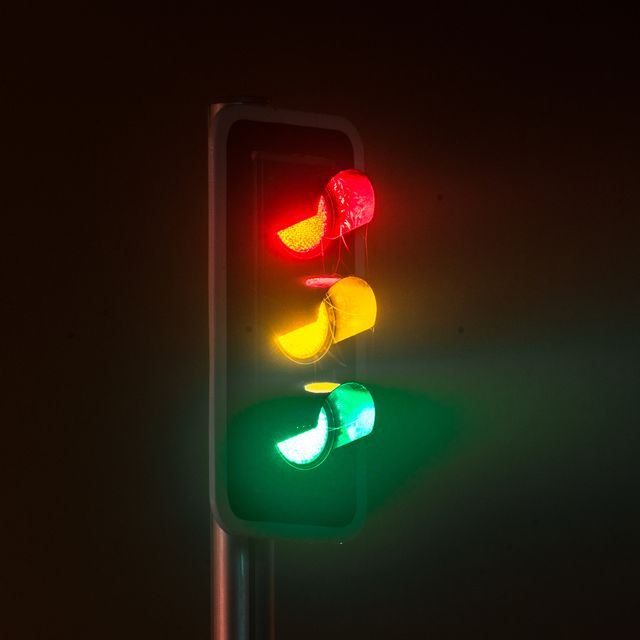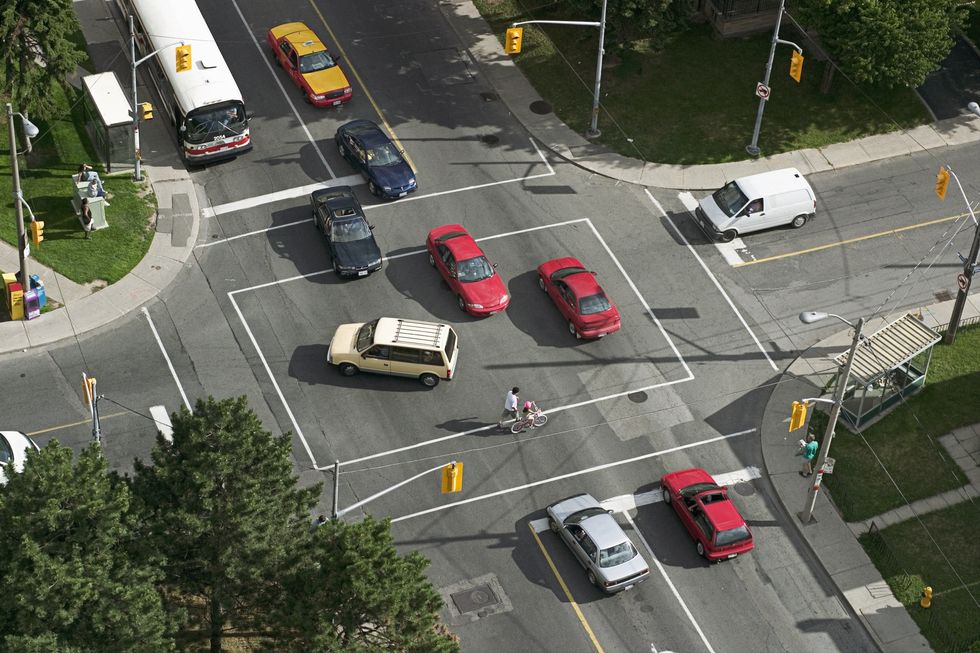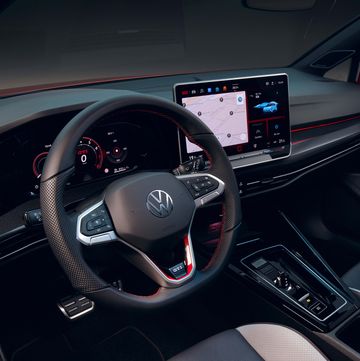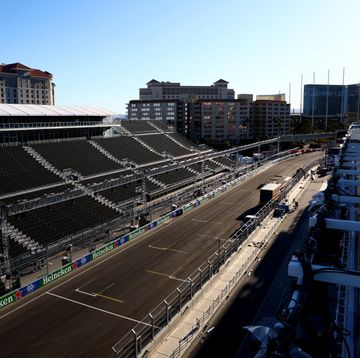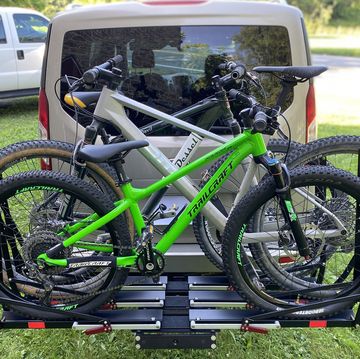Traffic lights are a quintessential part of our everyday lives—especially here in the United States. They play a critical role in controlling the flow of traffic, able to turn the spigot of traffic on and off in different directions.
However, the amount of congestion at any given intersection can vary wildly, everywhere from the steady drip of a garden hose to the shock and awe of a fire hose. That’s why it’s important to make sure all of the signals are working in harmony.
Things like traffic signals may seem incredibly simple, but we often question exactly how they work. Let’s dismantle the inner workings of systems that you interact with every day.
Traffic Light Signal Timing Plans
The simplest traffic light is a four-way intersection; one without any detectors, cameras, or outside intervention of any sort. A signal timing plan is the most basic way to control these lights. “It essentially says how long the light is going to stay green in each direction,” says Stephen Smith, a research professor of robotics at Carnegie Mellon University.
Next time you’re sitting at an intersection, look around to see if you can spot a cabinet or box nearby; this houses the control electronics that run the actual traffic light itself. This process can be as simple or complex as engineers want. According to Smith, every light, no matter how complicated, runs off a set of phases, which are changes that are congruent with the typical flow of traffic. Keeping with the four-way intersection example, phases make sure that the North/South lights are green while the East/West lights are red—among many other things.
All of these phases run in the same order, which creates a cycle that repeats itself throughout the day. While it might sound like a very set-it-and-forget-it type process, traffic engineers can tweak the timing of the cycle to better suit the conditions at the intersection throughout the day. Take your basic work commute for instance, which leads to more traffic in the morning and then again in the evening when the day is over and everyone is headed back home. In the middle of the day, the phases and timing of reds and greens might be longer because there is less regular congestion.
“Typically, a traffic engineer will go out to the intersection and count traffic in all directions in all phases for a day or two or three,” says Smith. He mentioned that engineers can use this data to best form—and adjust—the signal timing plan for that specific intersection. Along with adjusting from location to location, Smith said that some metropolitan areas will alter signal timing plans to handle larger groups of people leaving sports games or concerts.
Traffic Light Detectors
Signal timing plans sound great in theory, but the flow of traffic constantly changes hour by hour and even day by day. To keep up, you’d have to adjust the timing cycle every day, which is well… unrealistic. This is why most modern traffic lights use what are called detectors, which allow the phases to be altered in real time.
Most traffic lights use inductive-loop detectors to identify road users waiting at a light; this system uses a series of underground wires charged with alternating current to detect a vehicle once it rolls over the circuit. Next time you roll up to an intersection, look for any weird lines in the pavement behind the crosswalk where the first car or motorcycle in the queue pulls up to. The marks in the road line up with the wires for the inductive-loop system.
Inductive loops may be one of the most common detection solutions on the road today, but they aren’t totally bulletproof; one blaring disadvantage is the inability to identify how many cars are waiting behind a red light. Oftentimes, the best solution was to install one loop at the intersection with another one further back, but this only works when the lane is packed full. This is where cameras came along as a new and improved solution, able to easily tell how many cars are lined up and adjust the lights accordingly. In fact, cameras are generally a better solution full stop.
Smith said above-ground solutions like cameras bring much more capability compared the the binary nature of inductive loop detectors. The former can detect the type of vehicle sitting at an intersection—i.e. a truck, car, motorcycle, or even a cyclist. For instance, the digital detector would be able to identify a bus and give it priority over other motorists. “You’ll draw zones in the camera's field of view, which are presence zones,” says Smith; the vehicle is detected (and counted) when it interrupts the presence zone.
Critically, cameras would also be able to solve the age-old issue of motorcyclists (and bicycles) getting stranded at red lights that never turn green. Our two-wheeled friends can sometimes struggle to trip inductive-loop detectors due to their bikes having considerably less ferrous metals than any given automobile.
Thankfully there are already quite a few ways to avoid getting stuck at a “dead red.”
Dead Red Laws
Select U.S. states have heeded the hopelessness and frustration felt by our two-wheeled friends in this very situation, implementing what are sometimes called “dead red” laws. These allow road users (bicycles, motorcycles, and cars) to treat a malfunctioning red light as a stop sign; which would allow them to slowly proceed through the intersection with caution.
Most legislation doesn’t describe how long a light has to be red to be deemed “dead,” so use your best judgment.
Over 20 U.S. states currently have these so-called dead red rules, allowing road users to safely get through a broken light. See below for a quick list of states with rolling-red laws in place.
- Arkansas
- California
- Colorado
- Idaho
- Illinois
- Indiana
- Kansas
- Kentucky
- Minnesota
- Missouri
- Nevada
- North Carolina
- Ohio
- Oklahoma
- Oregon
- Pennsylvania
- South Carolina
- Tennessee
- Utah
- Virginia
- Washington
- Wisconsin
We’d like to note that this list is merely for quick reference. Please double-check your state’s rules and regulations before getting yourself through an intermittently functioning light.
🚦Call Your Local Public Works Department
If you live in a state that doesn’t allow you to run a “dead red,” you still have one last line of defense: your public works department. Traffic lights will likely fall under their jurisdiction, meaning you can call them to request an adjustment to that one pesky light that keeps holding you up.
The Future of Traffic Signals
Several advanced vehicle-detection projects at the Carnegie Mellon Traffic 21 laboratory are working on exciting technology that would further improve the accuracy and capabilities of detection systems.
One project that caught our attention involved integrating connected vehicles with existing traffic control systems, where automobiles would effectively be broadcasting their location and the roads they’d be using—all via short-range communication. All of this data (protected by immediate authentication) is a skeleton key that could unlock another level of traffic light efficiency. “I can immediately get you through our network around 20 percent faster and it doesn’t really adversely affect vehicles that aren’t connected,” says Smith.
Compared to the existing detection system we have using inductive loops and cameras, this could not only make the roads of the future safer, but also less congested.
Matt Crisara is a native Austinite who has an unbridled passion for cars and motorsports, both foreign and domestic. He was previously a contributing writer for Motor1 following internships at Circuit Of The Americas F1 Track and Speed City, an Austin radio broadcaster focused on the world of motor racing. He earned a bachelor’s degree from the University of Arizona School of Journalism, where he raced mountain bikes with the University Club Team. When he isn’t working, he enjoys sim-racing, FPV drones, and the great outdoors.
